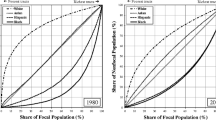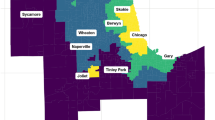Abstract
We merge metropolitan-level measures of racial discrimination in housing markets derived from two national housing audit studies, along with tract-level 1980 census data, with the 1979-1985 waves of the Panel Study of Income Dynamics to examine the impact of housing discrimination on patterns of residential mobility between neighborhoods of varying racial composition. We find no evidence that housing discrimination in the metropolitan area impedes African Americans' mobility into whiter neighborhoods. Contrary to expectations, in multivariate analyses based on black movers, the level of housing discrimination is positively associated with the percentage of the population that is white in the tract of destination. Housing discrimination against African Americans is positively associated with the rate at which mobile white households move into whiter census tracts. These findings imply that eliminating racial discrimination by real estate and rental agents will fail to increase black residential mobility into racially-mixed and predominantly white neighborhoods. For both black and white households, life-cycle factors, such as age, children, and home ownership, impede mobility out of the current neighborhood. Conditional upon moving, socioeconomic resources, such as education and income, facilitate mobility into whiter neighborhoods.
Similar content being viewed by others
References
Adams, T. K. (1991). Documentation for 1970 and 1980 census extract datasets. Ann Arbor, MI: Institute for Social Research, University of Michigan.
Alba, R.D. & Logan, J. R. (1993). Minority proximity to whites in suburbs: An individual level analysis of segregation, American Journal of Sociology98: 1388–1427.
Bye, B. V. & Riley, G. F. (1989). Model estimation when observations are not independent: Application of Liang and Zeger's methodology to linear and logistic regression analysis, Sociological Methods and Research17: 353–375.
Clark, W. A. V. (1986). Residential segregation in American cities:A review and interpretation, Population Research and Policy Review5: 95–127.
Clark, W. A. V. (1988). Understanding residential segregation in American cities: Interpreting the evidence, Population Research and Policy Review7: 113–121.
Clark, W. A. V. (1989). Residential segregation in American cities: Common ground and differences in interpretation, Population Research and Policy Review8: 193–197.
Clark, W. A.V. (1992). Residential preferences and residential choices in amultiethnic context, Demography29: 451–466.
Duncan, G. J. & Hill, D. H. (1989). Assessing the quality of household panel data: The case of the panel study of income dynamics, Journal of Business and Economic Statistics7: 441–452.
Elmi, A. H. N. & Mikelsons, M. (1991). Housing discrimination study: Replication of 1977 measures using current data. Washington, DC: US Department of Housing and Urban Development.
Fairchild, H. H.& Tucker, M. B. (1982). Black residential mobility: Trends and characteristics, Journal of Social Issues38: 51–74.
Farley, R. & Frey, W. H. (1994). Changes in the segregation of whites from blacks during the 1980s: Small steps toward a more integrated society, American Sociological Review59: 23–45.
Farley, R., Steeh, C., Krysan, M., Jackson, T., & Reeves, K. (1994). Stereotypes and segregation: Neighborhoods in the Detroit area, American Journal of Sociology100: 750–780.
Foley, D. L. (1973) Institutional and contextual factors affecting the housing choices of minority residents, pp. 85–147 in A. H. Hawley & V. P. Rock (eds.), Segregation in residential areas. Washington, DC: National Academy of Sciences.
Galster, G. C. (1986). More than skin deep: The effect of housing discrimination on the extent and pattern of racial residential segregation in the United States, pp. 119–138 in J. M. Goering (ed.), Housing desegregation and federal policy. Chapel Hill, NC: University of North Carolina Press.
Galster, G. C. (1988).Residential segregation in American cities:A contrary review, Population Research and Policy Review7: 93–112.
Galster, G. C. (1989). Residential segregation in American cities: A further response to Clark, Population Research and Policy Review8: 181–192.
Galster, G. C. (1991). Housing discrimination and urban poverty of African-Americans, Journal of Housing Research2: 87–122.
Galster, G. C. & Keeney, W. M. (1988). Race, residence, discrimination, and economic opportunity: Modeling the nexus of urban racial phenomena, Urban Affairs Quarterly24: 87–117.
Gramlich, E., Laren, D., & Sealand, N. (1992). Moving into and out of poor urban areas, Journal of Policy Analysis and Management11: 273–287.
Hill, M. S. (1992). The panel study of income dynamics: A user's guide. Newbury Park, CA: Sage.
Lee, B. A., Oropesa, R. S., & Kaman, J. W. (1994). Neighborhood context and residential mobility, Demography31: 249–270.
Long, L. (1988). Migration and residential mobility in the United States. New York: Russell Sage Foundation.
Massey, D. S. & Denton, N. A. (1993). American apartheid. Cambridge, MA: Harvard University Press.
Massey, D. S. Gross, A. B., & Shibuya, K. (1994). Migration, segregation, and the geographic concentration of poverty, American Sociological Review59: 425–445.
Nelson, K. P. & Edwards, J.G. (1993). Intra-urban mobility and location choice in the 1980s, pp. 53–95 in G.T. Kingsley & M.A. Turner (eds.), Housing markets and residential mobility. Washington, DC: The Urban Institute Press.
Rosenbaum, E. (1995). The making of a ghetto: Spatially concentrated poverty in New York City in the 1980s, Population Research and Policy Review14: 1–27.
Rossi, P. H. (1980). Why families move, 2nd edn. New York: Free Press.
South, S. J. & Crowder, K. D. (1996). Leaving the hood: Residential mobility between black, white, and integrated neighborhoods. Paper presented at the annual meetings of the Eastern Sociological Society, Boston, MA.
South, S. J. & Deane, G. D. (1993). Race and residential mobility: Individual determinants and structural constraints, Social Forces72: 147–167.
Speare, A. Jr., Goldstein, S., & Frey, W. H. (1975). Residential mobility, migration, and metropolitan change. Cambridge, MA: Ballinger.
Tienda, M. (1991). Poor people and poor places: Deciphering neighborhood effects on poverty outcomes, pp. 244–62 in J. Huber (ed.), Macromicro linkages in sociology. Newbury Park, CA: Sage.
Turner, M. A., Edwards, J. G., & Mikelsons, M. (1991). Housing discrimination study: Analyzing racial and ethnic steering. Washington, DC: US Department of Housing and Urban Development.
White, M. J. (1987). American neighborhoods and residential differentiation. New York: Russell Sage Foundation.
Wienk, R. E., Reid, C. E., Simonson, J. C., & Eggers, F. I. (1979). Measuring discrimination in American housing markets: The housing market practices survey. Washington, DC: US Department of Housing and Urban Development.
Wilson, W. J. (1987). The truly disadvantaged. Chicago: University of Chicago Press.
Winship, C. & Radbill, L. (1994). Sampling weights and regression analysis, Sociological Methods and Research23: 230–257.
Yinger, J. (1991). Housing discrimination study: Incidence of discrimination and variation in discriminatory behavior. Washington, DC: US Department of Housing and Urban Development.
Yinger, J. (1995). Closed doors, opportunities lost: The continuing costs of housing discrimination. New York: Russell Sage.
Author information
Authors and Affiliations
Rights and permissions
About this article
Cite this article
South, S.J., Crowder, K.D. Housing Discrimination and Residential Mobility: Impacts for Blacks and Whites. Population Research and Policy Review 17, 369–387 (1998). https://doi.org/10.1023/A:1005917328257
Issue Date:
DOI: https://doi.org/10.1023/A:1005917328257




